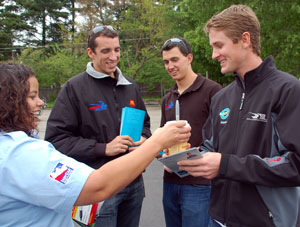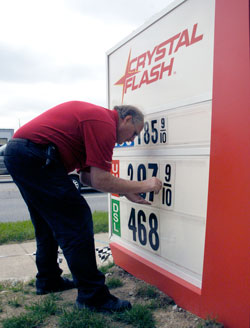 The Crystal Flash at Rangeline in Carmel, IN was the first gas station in the Indianapolis metro area to offer E85 fuel, and that was several years ago. Andy Batt, the Vice President of Merchandising for Crystal Flash fuel retailer, says E85 sales make up about four to five percent of all gallons of fuel sold at the Rangeline location. He says ethanol pump promotions like the one the Ethanol Promotion and Information Council and the Indiana Corn Marketing Council sponsored at his station offer great opportunities to pass savings along to consumers. He says it also helps educate them on what he says has become a very confusing topic. Andy (pictured third from left) says most consumers don’t realize the cost savings that E10 fuel brings to consumers at the pump. Couple that with the fact that the fuel also decreases foreign dependence on oil and, he says, consumers have a sound reason to opt for ethanol fuel blends.
The Crystal Flash at Rangeline in Carmel, IN was the first gas station in the Indianapolis metro area to offer E85 fuel, and that was several years ago. Andy Batt, the Vice President of Merchandising for Crystal Flash fuel retailer, says E85 sales make up about four to five percent of all gallons of fuel sold at the Rangeline location. He says ethanol pump promotions like the one the Ethanol Promotion and Information Council and the Indiana Corn Marketing Council sponsored at his station offer great opportunities to pass savings along to consumers. He says it also helps educate them on what he says has become a very confusing topic. Andy (pictured third from left) says most consumers don’t realize the cost savings that E10 fuel brings to consumers at the pump. Couple that with the fact that the fuel also decreases foreign dependence on oil and, he says, consumers have a sound reason to opt for ethanol fuel blends.
I caught up with Andy at today’s pump promotion. You can listen to why Andy thinks ethanol is a big part of fueling the future here: [audio:http://www.zimmcomm.biz/epic/bat-andy-pump.mp3]


 A man entrenched in the oil business is looking to the wind for the future.
A man entrenched in the oil business is looking to the wind for the future. Teams participating in Challenge X, a multi-year engineering competition with 17 university teams from across North America developing GM vehicles, is getting ready to pull into the nation’s capital.
Teams participating in Challenge X, a multi-year engineering competition with 17 university teams from across North America developing GM vehicles, is getting ready to pull into the nation’s capital.
 Newbie IndyCar Driver Justin Wilson (pictured 2nd from left) says race car drivers want to go as fast as technology will let them. He says ethanol helps IndyCars do just that. Justin is referring to the smaller tank size and the improved torque when burning 100 percent ethanol fuel. When the IndyCars operated on methanol just a few years ago, the gas tanks held 34 gallons. But now, drivers see the same kind of mileage while burning just 22 gallons of ethanol. Justin says that amounts to extra performance and higher speeds.
Newbie IndyCar Driver Justin Wilson (pictured 2nd from left) says race car drivers want to go as fast as technology will let them. He says ethanol helps IndyCars do just that. Justin is referring to the smaller tank size and the improved torque when burning 100 percent ethanol fuel. When the IndyCars operated on methanol just a few years ago, the gas tanks held 34 gallons. But now, drivers see the same kind of mileage while burning just 22 gallons of ethanol. Justin says that amounts to extra performance and higher speeds. Wind power builder National Wind Assessments is putting up a major project in Nebraska.
Wind power builder National Wind Assessments is putting up a major project in Nebraska. ,A new fuel made by mixing natural gas and hydrogen is gaining in popularity.
,A new fuel made by mixing natural gas and hydrogen is gaining in popularity.  …sweet-smelling that is. Graham Rahal, driver of the No. 06 Newman/Haas/Lanigan Dallara was one of three IndyCar drivers at the Crystal Flash pump promotion in Carmel, IN this afternoon. The
…sweet-smelling that is. Graham Rahal, driver of the No. 06 Newman/Haas/Lanigan Dallara was one of three IndyCar drivers at the Crystal Flash pump promotion in Carmel, IN this afternoon. The  Team Ethanol Driver Ryan Hunter-Reay says pump promotions help emphasize what ethanol is all about: giving consumers a break at the pump as fuel prices continue to spike. Ryan drives the No. 17
Team Ethanol Driver Ryan Hunter-Reay says pump promotions help emphasize what ethanol is all about: giving consumers a break at the pump as fuel prices continue to spike. Ryan drives the No. 17  It was a record-breaking event for the
It was a record-breaking event for the  The author of “
The author of “ In his book, Dr. Robert Zubrin shows how we could be using fuel dollars that are now being sent to countries with ties to terrorism to help farmers here and abroad. As the FEW keynote speaker, Zubrin will offer his vision of how switching to alcohol fuels could help safeguard homeland security and provide solutions for global warming and Third World development.
In his book, Dr. Robert Zubrin shows how we could be using fuel dollars that are now being sent to countries with ties to terrorism to help farmers here and abroad. As the FEW keynote speaker, Zubrin will offer his vision of how switching to alcohol fuels could help safeguard homeland security and provide solutions for global warming and Third World development.